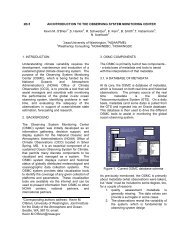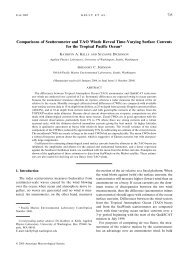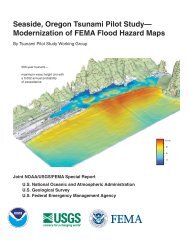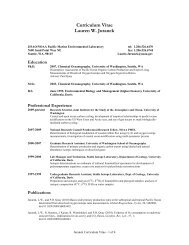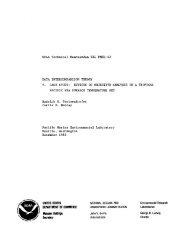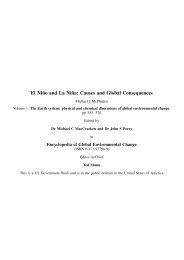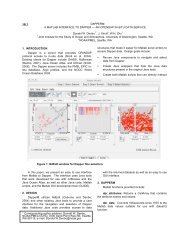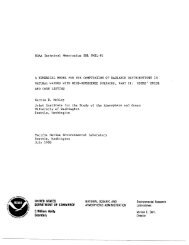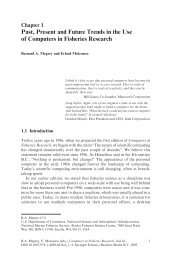Oceanographic conditions on the northern Bering Sea shelf: 1984 ...
Oceanographic conditions on the northern Bering Sea shelf: 1984 ...
Oceanographic conditions on the northern Bering Sea shelf: 1984 ...
You also want an ePaper? Increase the reach of your titles
YUMPU automatically turns print PDFs into web optimized ePapers that Google loves.
OCEANOGRAPHIC CONDITIONS ON THE NORTHERN BERING SEA SHELF:<br />
<strong>1984</strong>-1985<br />
S. Salol, R.D. Muench 2 , and J.D. Schumacher l<br />
1. INTRODUCTION<br />
Data presented in this Technical Memorandum were amassed as part of an experiment<br />
entitled <strong>the</strong> Arctic Polynya Experiment (APEX 85). The purpose of <strong>the</strong> experiment was to study<br />
mesoscale processes associated with ice formati<strong>on</strong> in <strong>the</strong> polynya south of St. Lawrence Island,<br />
in <strong>the</strong> nor<strong>the</strong>rn <strong>Bering</strong> <strong>Sea</strong>. Data were obtained from nine moorings c<strong>on</strong>taining seventeen current<br />
meters which were deployed near <strong>the</strong> island and in <strong>Bering</strong> Strait during October and November,<br />
<strong>1984</strong> (Table 1). The records from <strong>the</strong>se instruments were analyzed, and <strong>the</strong>ir statistical<br />
properties, spectra. and time series comparis<strong>on</strong>s am<strong>on</strong>g <strong>the</strong> records are presented in this memo.<br />
In additi<strong>on</strong>, data are compared to time-series of local winds derived from surface level pressure<br />
fields.<br />
1.1 Regi<strong>on</strong>al Geographical and <str<strong>on</strong>g>Oceanographic</str<strong>on</strong>g> Setting<br />
St. Lawrence Island is located about 300 Ian south of <strong>Bering</strong> Strait in <strong>the</strong> nor<strong>the</strong>rn <strong>Bering</strong><br />
<strong>Sea</strong> (Fig. 1). It is separated from mainland Alaska by Shpanberg Strait, which is about 190 Ian<br />
wide and is shallower than 30 m over much of its width. lsobaths in Shpanberg Strait are aligned<br />
toward <strong>the</strong> north or northwest. Anadyr Strait, to <strong>the</strong> west of <strong>the</strong> island, is about 75 Ian wide and<br />
deepens to greater than 50 m within about 20 Ian of St. Lawrence Island. Its bathymetric axes<br />
trend toward <strong>the</strong> nor<strong>the</strong>ast. <strong>Bering</strong> Strait is approximately 85 Ian wide and 40-60 m deep, with<br />
generally north-south trending isobaths. The regi<strong>on</strong> just south of St. Lawrence Island where<br />
most of <strong>the</strong> moorings were clustered is less than 40 m deep. lsobaths are roughly parallel to <strong>the</strong><br />
island except at 8401, <strong>the</strong> sou<strong>the</strong>rnmost mooring.<br />
Coachman et al. (1975) described three water masses in <strong>the</strong> <strong>Bering</strong> <strong>Sea</strong> north of 62°N.<br />
Fur<strong>the</strong>st west and most saline is Anadyr Water. Its high salinity is probably a result of salt<br />
excluded from ice formed during <strong>the</strong> winter <strong>on</strong> <strong>the</strong> Anadyr <strong>shelf</strong>. To <strong>the</strong> east of this water is<br />
<strong>Bering</strong> <strong>Sea</strong> Water. The regi<strong>on</strong> near <strong>the</strong> Alaskan coast is occupied by Alaskan Coastal Water.<br />
Because of river input this water mass is <strong>the</strong> least saline of <strong>the</strong> three. Schumacher et al. (1983)<br />
also reported <strong>on</strong> <strong>the</strong>se water masses.<br />
Tides are predominantly diurnal <strong>on</strong> <strong>the</strong> outer <strong>Bering</strong> <strong>Sea</strong> <strong>shelf</strong>, but become weaker and<br />
more semidiurnal toward <strong>the</strong> north (Pears<strong>on</strong> et al., 1981; Mofjeld, <strong>1984</strong>). Tidal currents are<br />
decreased when ice is present, although it is unclear whe<strong>the</strong>r <strong>the</strong> measured changes are real or<br />
reflect <strong>the</strong> decrease in rotor pumping by surface waves. Tidal variance represents 2-64% of <strong>the</strong><br />
total current variance during <strong>the</strong> winter at various sites in and near <strong>the</strong> area of <strong>the</strong> present study<br />
1 NOAA/PMEL. 7600 Sand Point Way N.E.• <strong>Sea</strong>ttle. WA 98115-0070<br />
2 Science Applicati<strong>on</strong>s Internati<strong>on</strong>al Corporati<strong>on</strong> (SAIC). 13400B Northrup Way. Suite 36.<br />
Bellevue. WA 98005



